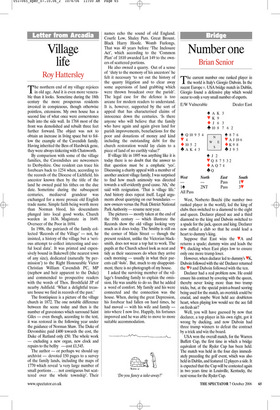Village life
Roy Hattersley
The northern end of my village rejoices in old age. And it is even more venerable than it looks. Sometime during the 18th century the more prosperous residents invested in conspicuous, though otherwise pointless, extensions. My own house has a second line of what once were cornerstones built into the side wall. In 1768 most of the front was demolished and rebuilt three feet further forward. The object was not to obtain an increase in living space but to follow the example of the Cavendish family. Having inherited the Bess of Hardwick gene, they were always tinkering with Chatsworth.
By comparison with some of the village families, the Cavendishes are newcomers to Derbyshire. One resident can trace his forebears back to 1254 when, according to the records of the Diocese of Lichfield, his ancestor known then by the title of the land he owned paid his tithes on the due date. Sometime during the subsequent centuries, mediaeval grandeur was exchanged for a more prosaic old English trade name. Simple faith being worth more than Norman blood, his descendants plunged into local good works. Church warden in 1636. Magistrate in 1649. Overseer of the Poor in 1694.
In 1906, the patriarch of the family collected ‘Records of the Village’ — not, he insisted, a history of the village but a ‘serious attempt to collect interesting and useful local data’. It was printed and expensively bound in Bakewell (the nearest town of any size), dedicated (naturally ‘by permission’) to the Right Honourable Victor Christian William Cavendish PC, MP (nephew and heir apparent to the Duke) and commended to prospective readers with the words of Thos. Broshfield JP of nearby Ashfield. ‘What a delightful treasure house we find in records of the past.’ The frontispiece is a picture of the village church in 1872. The one notable difference between the scene today and then is the number of gravestones which surround Saint Giles — even though, according to the text, it was restored in the following year under the guidance of Norman Shaw. The Duke of Devonshire paid £400 towards the cost, the Duke of Rutland only £50. The whole work — excluding a new organ, new clock and repairs to the belfry — cost £1,545.
The author — or perhaps we should say archivist — devoted 150 pages to a survey of the family lands, including the maps of 1770 which reveal ‘a very large number of small portions ... not contiguous but scattered over the whole township’. Their names echo the sound of old England. Courfe Low, Shaley Puts. Great Brount. Black Harry Hoofe. Womb Furlongs. That was 40 years before ‘The Inclosure Act’, which according to the ‘Common Plan’ of 1810 awarded Lot 149 to the owners of scattered portions.
He also owned a quarry. Out of a sense of ‘duty to the memory of his ancestors’ he felt it necessary ‘to set out the history of the quarry litigation and to clear away some aspersions of land grabbing which were thrown broadcast over the parish’. The legal case for the defence is too arcane for modern readers to understand. It is, however, supported by the sort of appeal that has characterised claims of innocence down the centuries. ‘Is there anyone who will believe that the family who have again and again given land for parish improvements, benefactions for the poor and donations of money and kind including the outstanding debt for the church restoration would lay claim to a piece of land of no earthly value?’ If village life in 1895 was anything like it is today there is no doubt that the answer to that question must be a emphatic ‘yes’. Discussing a charity appeal with a member of another ancient village family, I was surprised to find how much animosity was directed towards a self-evidently good cause. ‘Ah,’ she said with resignation. ‘That is village life.’ And history does repeat itself. Legal arguments about quarrying on our boundaries new owners versus the Peak District National Park Authority — resume next year.
The pictures — mostly taken at the end of the 19th century — which illustrate the Records show the old village looking very much as it does today. The Smithy is still on the corner of Main Street — though the present resident, unlike the Victorian blacksmith, does not wear a top hat to work. The pupils at the Church school look as neat and tidy as their successors do when they arrive each morning — usually in what their parents call ‘4x4s’. But, much to my disappointment, there is no photograph of my house.
I asked the surviving member of the village’s founding family to explain the omission. He was unable to do so. But he added a word of comfort. My family and his were connected and the connection was the house. When, during the great Depression, his forebear had fallen on hard times, he had moved — with his wife and family into where I now live. Happily, his fortunes improved and he was able to move to more suitable accommodation.


















































































 Previous page
Previous page